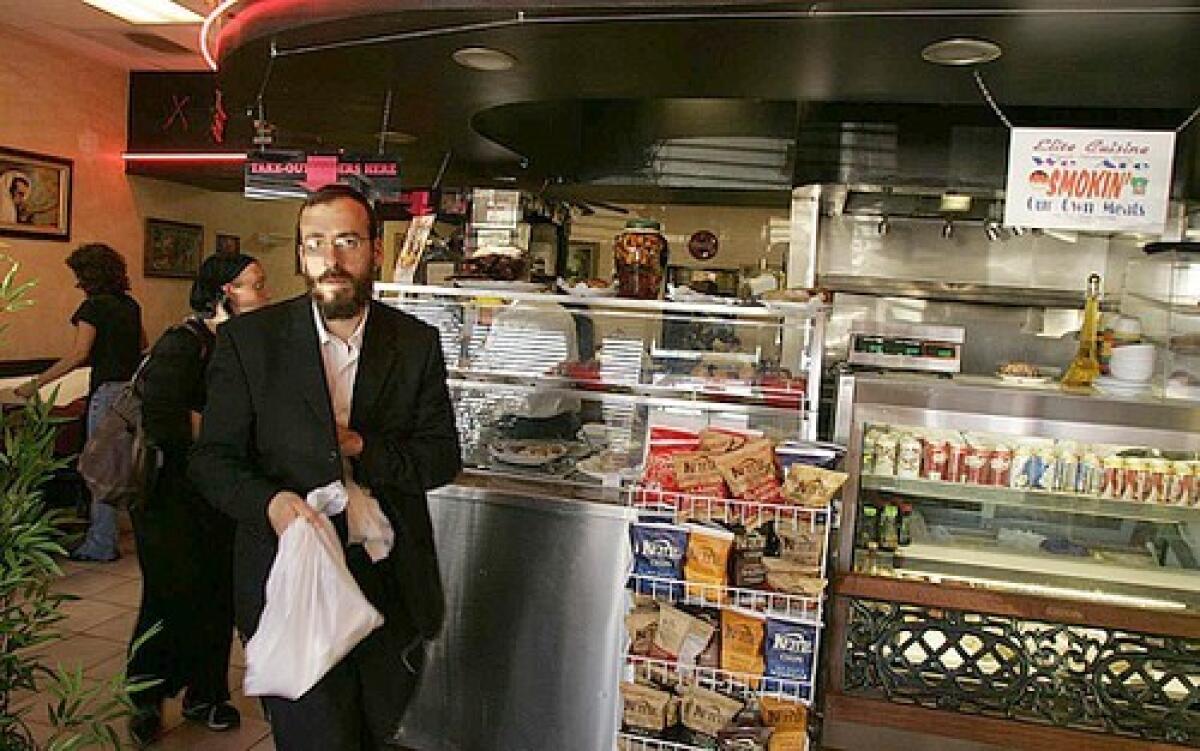Kindred spirits can call this place home

- Share via
An eruv district is a symbolic zone where Orthodox Jews are permitted to carry items and push strollers on the Sabbath. Chances are, most other people who live within Los Angeles’ eruv don’t even know it’s there.
What it’s about
The Jewish Sabbath, which begins at sundown on Fridays and ends at nightfall on Saturdays, is a time for prayer and Torah study, when observant Jews refrain from activities considered “work,” such as driving, turning on the lights, answering the telephone or carrying items. The Sabbath also is marked by festive meals, singing and socializing with family and friends.
Rooted in ancient times, when Jews lived in close proximity to one another, the two elements of Sabbath — as a day of rest and also a day of socializing — sometimes clash in modern times. Because of the restrictions observed during the Sabbath and certain Jewish holidays, Orthodox Jews of modern times have been stymied when it came to transporting babies, toddlers, the elderly and disabled — not to mention carrying a challah or dessert to families’ and friends’ homes — thereby limiting their social interactions, an important component of the observance. That’s why eruvim (plural for eruv) were established.
The eruv district, a concept first instituted in King Solomon’s religious court, is distinguished from a public domain — where the carrying of any objects during the Sabbath is prohibited. In the smaller eruv area, some carrying is allowed (strollers, food, house keys and medicines, for example). This symbolically private domain is determined by its physical enclosure, which in small towns is bound by poles and wire, but in Los Angeles primarily by freeway walls and fences.
The present Los Angeles Community Eruv — which includes Hancock Park, West Hollywood, Beverly Hills, Westwood and the Pico-Robertson area — is 80 square miles and bordered, roughly, by the 10, 101 and 405 freeways. It was established about 2 1/2 years ago; formerly, there were a number of smaller eruvim in the city, said Mickey Fenig, an attorney who helped create the new district.
After consulting with experts in Israel, poring over local maps and driving the freeways, the eruv committee got permission from city and state officials to establish the district. Eruv members, with advice from Caltrans, did the physical work and currently maintain the fences and walls with funds from the eruv budget.
Housing stock
Residents of Hancock Park — a popular neighborhood in the Los Angeles Community Eruv — whether Jewish or not, are drawn to the large, older homes known for their architecture and character, many built in the early 1900s to the 1930s.Gentrification over the last decade has spawned a slew of popular restaurants, kosher and otherwise, and boutiques and furniture stores in the surrounding area that includes La Brea Avenue, 3rd Street, Beverly Boulevard and Melrose Avenue.
Insiders’ viewpoint
When Enoch and Yocheved Kimmelman decided to leave their extended families behind in El Paso and move their four children to Los Angeles for the city’s private religious schools, they called the only friend they knew here to find out where to live. That friend mentioned Coldwell Banker real estate agent Cecille Cohen, who knew many of the Orthodox Jews in the Hancock Park section of the eruv, and she started introducing the couple to those who would quickly become their extended family.After renting for two years — it took time to find a property they could afford — they landed the perfect home, with four bedrooms to comfortably house a large family and a dining room spacious enough to accommodate extended family and friends on the Sabbath and holidays.
They visited a number of synagogues within walking distance of their home and settled on Young Israel of Hancock Park. The children, along with many of their neighborhood peers, ride a bus to a private religious school in Culver City.
“In El Paso, my wife felt home-bound,” Enoch said. “In the eruv, she can push a stroller to a friend’s house for Friday dinner or to the synagogue. Now she’s much freer.”
What the agents say
For the most part, people who aren’t Jewish aren’t even aware they live in an eruv. Orthodox Jews, on the other hand, often settle in the neighborhood to be close to necessary amenities. Nearby markets and schools make those neighborhoods particularly appealing and property values are high due to the demand. Agents point out, however, that Beverly Hills, Hancock Park and parts of West Hollywood always have been in demand and pricey.
Real estate agents are prohibited by law from telling clients that a certain neighborhood is close to a church or temple or that it is predominantly Jewish or any other religion. But most buyers in Hancock Park — which is demographically eclectic — chose the area because it met their particular needs and they love the quality of life that came with it, Cohen said.
diane.wedner@latimes.com
Sources: Cecille Cohen, Coldwell Banker Hancock Park North; Coldwell Banker agent Leah Brenner, https://www.naomiandleah.com ; https://www.laeruv.com ; https://www.valleyeruv.org ; https://www.sametla.com .


